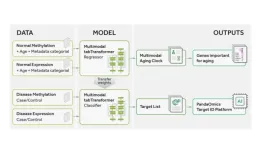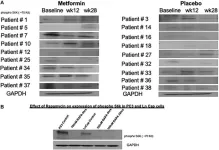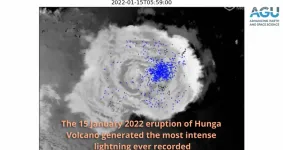(Press-News.org) Hidden beneath the waves of coastal waters lies an important member of the marine food chain – seagrasses. These marine meadows are in many ways the unsung heroes of the ocean, benefiting humans and the planet by producing oxygen, removing carbon dioxide from the air, and providing food and habitat for marine life. But these submerged savannahs may be in danger of disappearing, according to a new Stanford study that modeled the distribution of seagrass species around the world at two different timepoints in the future.
Climate change is expected to hit marine species hard, in part because oceans absorb an estimated 80 percent of excess heat from greenhouse gas emissions. Yet it’s not fully known how seagrasses will fare in the future, or if the current network of marine protected areas can save seagrasses.
“The simple question we ask in this paper is, ‘How will seagrasses – which are a foundational group in the marine food chain – respond to climate change?’ ” said Barnabas Daru, assistant professor of biology in the Stanford School of Humanities and Sciences.
Seagrasses are an ancient group of plants that originated in the ocean, moved to land, and then returned to the sea roughly 140 million years ago. They provide grazing grounds for herbivores, like endangered green sea turtles, manatees, and parrotfish; they shelter shrimp, marine invertebrates, and fish; and are nurseries for roughly 20 percent of the world’s large commercial fisheries.
Many marine organisms depend directly on seagrasses for survival, but many more indirectly benefit from seagrasses.
“For example, sharks feed on marine animals that, in turn, may feed directly or indirectly on plants,” said Daru, who is the lead author of the study conducted with Brianna M. Rock, a researcher at Clearwater Marine Aquarium Research Institute in Florida that published June 19 in the journal Nature Plants.
“If anything affects these foundational species at the beginning of the food chain, it will have cascading effects on other organisms that depend on them high up in the food chain, including humans,” said Daru.
Modeling seagrasses worldwide
Seagrasses fan out across roughly 116,000 square miles of coastline bordering 191 countries on all continents except Antarctica. Modeling how climate change might affect seagrasses around the world is no small feat.
Daru and Rock began by mapping the location and abundance of each seagrass species using roughly 100 years of seagrass samples collected from coastal ecosystems. They combined these data with records they gathered in the field and information gleaned from public databases of seagrass occurrence, like the Global Biodiversity Information Facility and Seagrass-Watch. They overcame uneven sampling by using data from well-sampled areas, like North America and Europe, to model predicted seagrass habitats for under sampled areas like Southeast Asia and the Indo-Pacific.
Next, they created global “snapshots” representing the ocean’s climate today, and how it might be in the time periods of 2040-2050 and 2090-2100 using geophysical and environmental data from the Bio-ORACLE website.
For the present and two future time periods, Daru modeled four different scenarios: a “best-case” climate with low greenhouse gas concentrations; two stabilized scenarios where greenhouse gas levels plateaued; and a “worst-case” scenario with high greenhouse gas concentrations. These modeled scenarios included data on sea temperature, salinity, and sea current speed – all variables known to significantly influence seagrass growth, distribution, and photosynthesis.
Finally, to predict how seagrass populations and distributions might change between the present day and two future timepoints, Daru applied a computer model of the observed species occurrences to each climate scenario.
Saving seagrasses of tomorrow
The study revealed that seagrasses will incur widespread reductions in species diversity and composition with a significant proportion of seagrasses suffering in hotspots that occur outside of the current marine network of marine protected areas. Notably, the researchers found that seagrasses declined in abundance and composition under every scenario they tested, even the “best case” scenario. So what does this mean?
“It probably means that ‘the best’ is still not enough,” Daru said. “We have to be more intentional in how conservation efforts are prioritized and this sort of analysis points to the places where these efforts should be done.”
Importantly, the findings of this study also indicate that the current network of marine protected areas is not sufficient.
“One of the signatures of this modern era of profound human impact on the environment is not even the loss of species, but the reorganization of biotic communities. The homogenization of communities is likely to lead to a more profound impact on biodiversity than even the loss of species,” Daru said.
When ecosystems become homogenized they lose their distinctiveness and uniqueness, and the decrease in diversity makes them more susceptible to disease and extreme weather events. Such a change could impact both the ecosystem services provided by these communities and the marine life that depends on them. It also may force marine animals that specialize on certain seagrasses to relocate or adapt to less favored seagrass species if their preferred seagrass is lost, which can reduce their fitness and survival.
Despite these sobering findings, the future of seagrasses is far from hopeless.
“We highlighted hotspots of change in species diversity and phylogenetic diversity that represent priority regions to target for conservation efforts,” Daru said. “Our goal, our hope is that by pointing policymakers and conservationists to focus on these hotspots, marine protection will be increased in these areas and the future of seagrasses will – to some extent – be safeguarded.”
This research was supported by the U.S. National Science Foundation.
END
Study explores climate change impacts on seagrass meadows
2023-06-21
ELSE PRESS RELEASES FROM THIS DATE:
Helping define the impact of “art” in education
2023-06-20
Growing up, Brian Kisida always enjoyed going to school. He especially enjoyed the broad spectrum of subjects he was able to explore, including the arts. Now, as an assistant professor in the Truman School of Government and Public Affairs at the University of Missouri, he is researching the relationship between arts education and student success.
Over the years, Kisida, an expert on education policy, has seen the culture of education shift dramatically.
“I saw the impact that the test obsessed culture had on schooling, students’ mental health and enjoyment of learning,” Kisida said. “I wanted to know why we were seeing these changes that seem to not be in line ...
Precious1GPT: multimodal transfer learning for aging clock development and target discovery
2023-06-20
“The development of Precious1GPT [...] has demonstrated the potential of our approach in deciphering the molecular mechanisms of aging.”
BUFFALO, NY- June 20, 2023 – A new research paper was published in Aging (listed by MEDLINE/PubMed as "Aging (Albany NY)" and "Aging-US" by Web of Science) Volume 15, Issue 11, entitled, “Precious1GPT: multimodal transformer-based transfer learning for aging clock development and feature importance analysis for aging and age-related disease target discovery.”
Aging is a complex ...
Metformin's role in preventing metabolic syndrome during androgen deprivation therapy: a Phase II study
2023-06-20
“[...] we found no impact of the addition of metformin to [androgen deprivation] therapy on risk of metabolic syndrome associated with castration therapy and no additional anti-tumor effects.”
BUFFALO, NY- June 20, 2023 – A new research paper was published in Oncotarget's Volume 14 on June 19, 2023, entitled, “Utilizing metformin to prevent metabolic syndrome due to androgen deprivation therapy (ADT): a randomized phase II study of metformin in non-diabetic men initiating ADT for advanced prostate cancer.”
Androgen deprivation therapy (ADT) can lead to metabolic syndrome (MS) and is implicated in ADT-resistance. Metformin showed antineoplastic ...
Study: Microtargeting works, just not the way people think
2023-06-20
Recent U.S. elections have raised the question of whether “microtargeting,” the use of extensive online data to tailor persuasive messages to voters, has altered the playing field of politics.
Now, a newly-published study led by MIT scholars finds that while targeting is effective in some political contexts, the “micro” part of things may not be the game-changing tool some have assumed.
“In a traditional messaging context where you have one issue you’re trying ...
Brazilian fossil provides earliest evidence of evolutionary trait that enabled dinosaurs to become giants
2023-06-20
The missing link has just been found between the earliest dinosaurs, whose size ranged from a few centimeters to at most 3 meters in length, and more recent giants that could be more than twice the length of a bus and have so much appeal to the popular imagination.
Macrocollum itaquii, buried 225 million years ago in what is now Agudo, a town in Rio Grande do Sul state, South Brazil, is the oldest dinosaur studied hitherto with structures called air sacs.
These bone cavities, which persist in present-day ...
What role does alternative splicing play in neurodegenerative disease?
2023-06-20
RIVERSIDE, Calif. -- Alternative splicing, a clever way a cell generates many different variations of messenger RNAs — single-stranded RNAs involved in protein synthesis — and proteins from the same stretch of DNA, plays an important role in molecular biology. Progressing rapidly, the field of alternative splicing is a complex topic and the scientific literature on it is already extensive.
David Nikom, a student in the UC Riverside Neuroscience Graduate Program, and his advisor, Sika Zheng, an associate professor of biomedical sciences in the UCR School of Medicine and director of the Center ...
Tonga’s Hunga eruption produced the most intense lightning ever recorded
2023-06-20
American Geophysical Union
Release No. 23-26
20 June 2023
For Immediate Release
This press release and accompanying multimedia are available here: https://news.agu.org/press-release/tongas-hunga-eruption-produced-the-most-intense-lightning-ever-recorded/
Additional study highlights:
The 15 January eruption lasted at least 11 hours, several hours longer than previously known
The plume produced the highest-altitude lightning flashes ever measured, 20 to 30 kilometers (12 to 19 miles) above sea level
Lightning “surfed” giant waves that rippled through volcanic plume
Lightning data ...
Rensselaer researcher to investigate the mechanics of mitosis to combat cancer
2023-06-20
It is a scary fact that one in two women and one in three men in the United States will develop some form of cancer in their lifetime. One of the hallmarks of many cancers is the occurrence of errors during the cell division process called mitosis. Therefore, critical to enhancing treatments or perhaps even finding a cure for cancer and other diseases, is developing a better understanding of how mitosis works in both healthy and diseased cells.
Rensselaer Polytechnic Institute’s Scott Forth, Ph.D., assistant professor of biological sciences ...
Mason College of Public Health researchers reveal how digital contact tracing applications can be utilized now that the pandemic is over
2023-06-20
During the pandemic, contact tracing apps kept Americans informed of potential exposure risk with the goal of reducing infections. But did apps like this help reduce the spread of COVID and how might we improve these apps for use in future outbreaks?
Contact tracing is a pivotal part of pandemic preparedness. Evidence-based research on best practices for contact tracing is important because when employed inefficiently contact tracing drains resources. Used effectively, contact tracing slows the spread of disease and saves lives. In the past, contact tracing was done through health ...
UNCG spin-off launches national study to help prevent opioid misuse
2023-06-20
Prevention Strategies received a grant from the National Institutes of Health to pursue the study and develop a commercially viable intervention tool based on prevention science. Known as WorkWell, it is a tailored mobile health app that represents the next generation of evidence-based, technology-aided intervention programs.
The initial pilot program to test the WorkWell app will focus on construction trade workers and nurses, as well as nursing assistants and technicians. These occupations have been disproportionately impacted by the opioid crisis and have high mortality ratios.
“Opioid-involved overdoses are among the leading causes of death in the United States despite extensive ...






